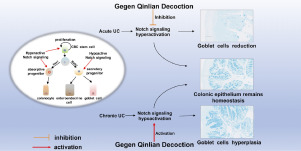当前位置:
X-MOL 学术
›
Phytomedicine
›
论文详情
Our official English website, www.x-mol.net, welcomes your
feedback! (Note: you will need to create a separate account there.)
Gegen Qinlian decoction maintains colonic mucosal homeostasis in acute/chronic ulcerative colitis via bidirectionally modulating dysregulated Notch signaling.
Phytomedicine ( IF 6.7 ) Pub Date : 2020-02-07 , DOI: 10.1016/j.phymed.2020.153182 Yaxing Zhao 1 , Haofan Luan 1 , Hui Gao 1 , Xiaojun Wu 2 , Yubin Zhang 1 , Ruiyan Li 1
Phytomedicine ( IF 6.7 ) Pub Date : 2020-02-07 , DOI: 10.1016/j.phymed.2020.153182 Yaxing Zhao 1 , Haofan Luan 1 , Hui Gao 1 , Xiaojun Wu 2 , Yubin Zhang 1 , Ruiyan Li 1
Affiliation

|
BACKGROUND
Gegen Qinlian decoction (GQ) is a well-known traditional Chinese medicine that has been clinically proven to be effective in treating ulcerative colitis (UC). However, its therapeutic mechanism has not been fully elucidated. Notch signaling plays an essential role in the regeneration of the intestinal epithelium.
PURPOSE
This study was designed to ascertain the mechanism by which GQ participates in the recovery of the colonic mucosa by regulating Notch signaling in acute and chronic UC models.
METHODS
Acute and chronic UC mice (C57BL/6) were established with 3 and 2% dextran sulfate sodium (DSS), respectively, and treated with oral administration of GQ. The expression of the Notch target gene Hes1 and the Notch-related proteins RBP-J, MAML and Math1 was analyzed by western blotting. PTEN mRNA levels were detected by qRT-PCR. Mucin production that is characteristic of goblet cells was determined by Alcian blue/periodic acid-Schiff staining and verified by examining MUC2 mRNA levels by qRT-PCR. Cell proliferation was assayed by immunohistochemistry analysis of Ki67. HT-29 and FHC cells and Toll-like receptor 4 knockout (TLR4-/-) acute UC mice were also used in this study.
RESULTS
GQ restored the injured colonic mucosa in both acute and chronic UC models. We found that Notch signaling was hyperactive in acute UC mice and hypoactive in chronic UC mice. GQ downregulated Hes1, RBP-J and MAML proteins and augmented goblet cells in the acute UC models, whereas GQ upregulated Hes1, RBP-J and MAML proteins in chronic UC mice, reducing goblet cell differentiation and promoting crypt base columnar (CBC) stem cell proliferation. Hes1 mRNA was suppressed in TLR4-/- UC mice, and GQ treatment reversed this effect. In vitro, GQ reduced Hes1 protein in Notch-activated HT29 and FHC cells but increased Hes1 protein in Notch-inhibited cells.
CONCLUSIONS
GQ restored the colonic epithelium by maintaining mucosal homeostasis via bidirectional regulation of Notch signaling in acute/chronic UC models.
中文翻译:

葛根秦连汤通过双向调节Notch信号传导异常来维持急性/慢性溃疡性结肠炎的结肠粘膜稳态。
背景技术葛根Q连汤(GQ)是一种著名的中药,已被临床证明可有效治疗溃疡性结肠炎(UC)。但是,其治疗机制尚未完全阐明。缺刻信号在肠上皮的再生中起重要作用。目的本研究旨在通过调节急性和慢性UC模型中的Notch信号来确定GQ参与结肠粘膜恢复的机制。方法分别用3%和2%的葡聚糖硫酸钠(DSS)建立急性和慢性UC小鼠(C57BL / 6),并口服GQ进行治疗。通过蛋白质印迹分析Notch靶基因Hes1和Notch相关蛋白RBP-J,MAML和Math1的表达。通过qRT-PCR检测PTEN mRNA水平。杯状细胞特征性的粘蛋白产生是通过阿尔辛蓝/高碘酸-希夫(Schiff)染色确定的,并通过qRT-PCR检查MUC2 mRNA的水平来验证。通过Ki67的免疫组织化学分析测定细胞增殖。HT-29和FHC细胞以及Toll样受体4敲除(TLR4-/-)急性UC小鼠也用于这项研究。结果GQ在急性和慢性UC模型中均恢复了受伤的结肠粘膜。我们发现Notch信号在急性UC小鼠中活跃,而在慢性UC小鼠中活跃。GQ在急性UC模型中下调Hes1,RBP-J和MAML蛋白并增强杯状细胞,而GQ在慢性UC小鼠中上调Hes1,RBP-J和MAML蛋白,减少杯状细胞分化并促进隐窝基底柱状(CBC)干细胞增殖。Hes1 mRNA在TLR4-/-UC小鼠中被抑制,而GQ处理可逆转此效果。在体外,GQ在Notch激活的HT29和FHC细胞中减少了Hes1蛋白,但在Notch抑制的细胞中增加了Hes1蛋白。结论GQ通过双向调节Notch信号在急性/慢性UC模型中维持黏膜稳态来恢复结肠上皮。
更新日期:2020-02-07
中文翻译:

葛根秦连汤通过双向调节Notch信号传导异常来维持急性/慢性溃疡性结肠炎的结肠粘膜稳态。
背景技术葛根Q连汤(GQ)是一种著名的中药,已被临床证明可有效治疗溃疡性结肠炎(UC)。但是,其治疗机制尚未完全阐明。缺刻信号在肠上皮的再生中起重要作用。目的本研究旨在通过调节急性和慢性UC模型中的Notch信号来确定GQ参与结肠粘膜恢复的机制。方法分别用3%和2%的葡聚糖硫酸钠(DSS)建立急性和慢性UC小鼠(C57BL / 6),并口服GQ进行治疗。通过蛋白质印迹分析Notch靶基因Hes1和Notch相关蛋白RBP-J,MAML和Math1的表达。通过qRT-PCR检测PTEN mRNA水平。杯状细胞特征性的粘蛋白产生是通过阿尔辛蓝/高碘酸-希夫(Schiff)染色确定的,并通过qRT-PCR检查MUC2 mRNA的水平来验证。通过Ki67的免疫组织化学分析测定细胞增殖。HT-29和FHC细胞以及Toll样受体4敲除(TLR4-/-)急性UC小鼠也用于这项研究。结果GQ在急性和慢性UC模型中均恢复了受伤的结肠粘膜。我们发现Notch信号在急性UC小鼠中活跃,而在慢性UC小鼠中活跃。GQ在急性UC模型中下调Hes1,RBP-J和MAML蛋白并增强杯状细胞,而GQ在慢性UC小鼠中上调Hes1,RBP-J和MAML蛋白,减少杯状细胞分化并促进隐窝基底柱状(CBC)干细胞增殖。Hes1 mRNA在TLR4-/-UC小鼠中被抑制,而GQ处理可逆转此效果。在体外,GQ在Notch激活的HT29和FHC细胞中减少了Hes1蛋白,但在Notch抑制的细胞中增加了Hes1蛋白。结论GQ通过双向调节Notch信号在急性/慢性UC模型中维持黏膜稳态来恢复结肠上皮。











































 京公网安备 11010802027423号
京公网安备 11010802027423号